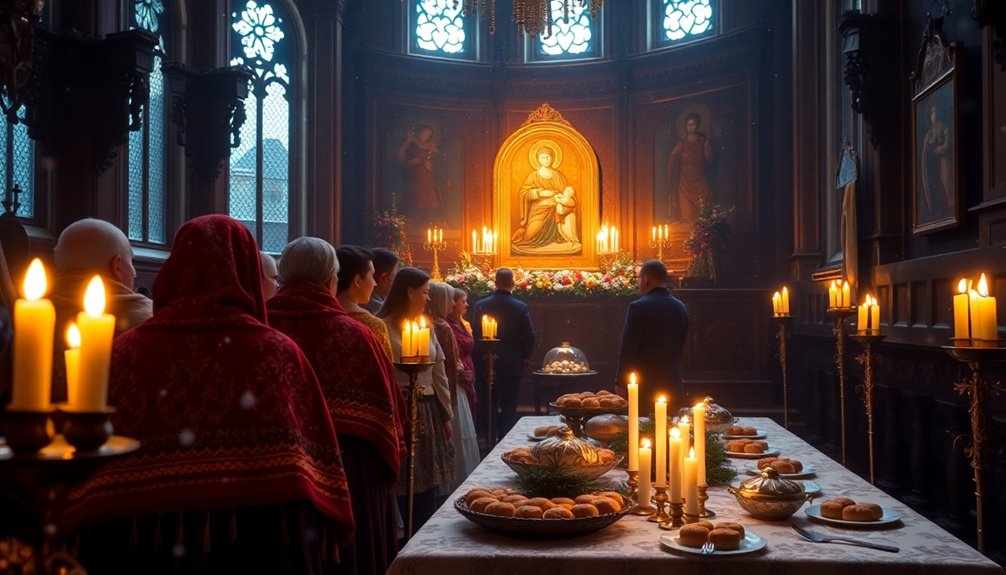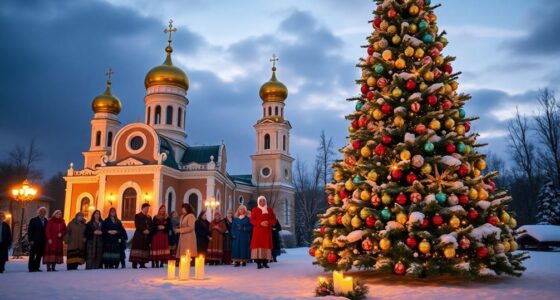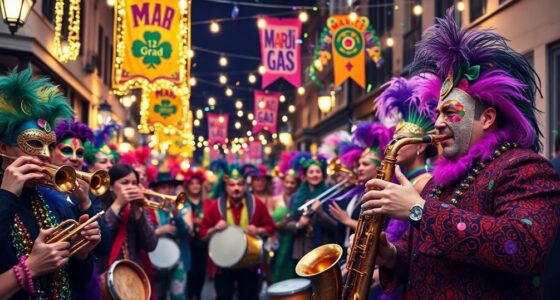On Russian Orthodox Christmas, you'll find a beautiful blend of tradition and family spirit. It's celebrated on January 7, starting with a special meal called Sviata Vechera, featuring 12 meatless dishes that honor the apostles, with kutya as the star. You'll wait for the first star to appear before enjoying a midnight church service, followed by hymns and prayers. Families gather around the table adorned with a white cloth and hay, symbolizing Jesus's swaddling clothes. Children sing carols for blessings, while the Christmas spirit is palpable in communal gatherings and lively markets, and there's so much more to explore!
Key Takeaways
- Russian Orthodox Christmas is celebrated on January 7, following the Julian calendar, with roots dating back to the 10th century.
- Families gather for Sviata Vechera, a festive meal featuring 12 meatless dishes, including the traditional Kutya.
- The Holy Supper begins with prayers and the appearance of the first star on Christmas Eve, symbolizing the Star of Bethlehem.
- Attendees often participate in a midnight church service (Prazdnik), celebrating the birth of Christ with hymns and prayers.
- Children sing kolyadki on Christmas morning, receiving blessings and treats, while community celebrations include traditional markets and festive events.
Historical Context of Russian Christmas
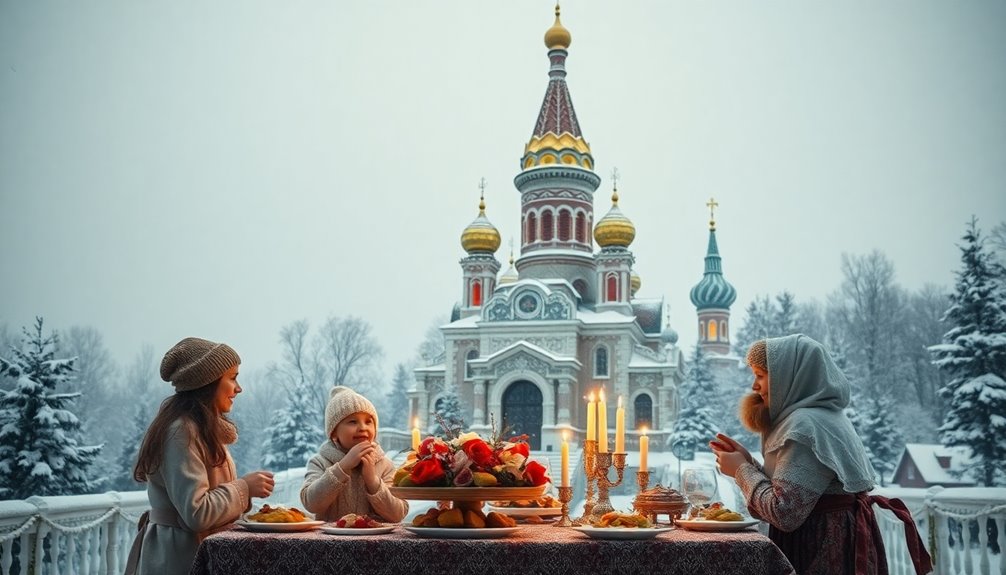
While many people celebrate Christmas on December 25, Russians mark the occasion on January 7, following the Julian calendar. The roots of Russian Orthodox Christmas trace back to the late 10th century when Prince Vladimir baptized Rus, establishing Orthodox Christianity in the region.
However, the Soviet Union banned Christmas celebrations in 1929, pushing these traditions underground until 1991. After the fall of the Soviet regime, traditional celebrations resurfaced, and Christmas was reinstated as a national holiday.
The introduction of the Christmas tree in the 19th century, influenced by Alexandra Feodorovna from Prussia, added a festive touch. Despite its significance, modern-day Christmas often takes a backseat to New Year celebrations, which dominate Russian cultural festivities.
Family Gatherings and Traditions
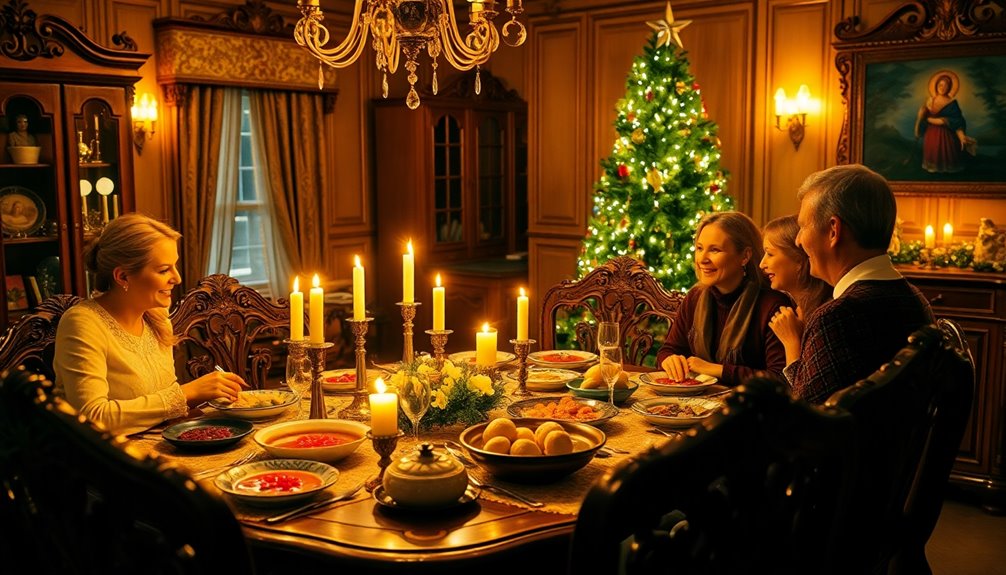
When you gather with family for Russian Orthodox Christmas, the feast becomes a highlight of the celebration.
You'll enjoy the traditional "Sviata Vechera," featuring 12 meatless dishes, and perhaps share a moment of gift exchange, even if it's more common during New Year's.
These customs not only reinforce bonds but also create a warm, communal spirit that defines the holiday.
Family Feast Customs
As families gather for the Russian Orthodox Christmas, the celebration centers around a special meal known as "Sviata Vechera."
This feast, featuring 12 meatless dishes that symbolize the apostles, brings loved ones together in a spirit of unity and forgiveness. One of the highlights is "Kutya," a sweet grain pudding made with honey and poppy seeds.
The table is adorned with a white cloth and hay, representing Jesus's swaddling clothes and the manger. Family members share Lenten bread dipped in honey and garlic, reinforcing their bonds.
After the Christmas Eve meal, everyone often attends a midnight church service, further strengthening their communal ties and emphasizing the importance of togetherness during this cherished holiday.
Gift Exchange Practices
Following the warmth of the family feast, the spirit of giving takes center stage during the holiday season. In Russia, gift exchange primarily happens on New Year's Eve, with Christmas gifts focusing on small tokens that emphasize love and togetherness. Traditional gifts like hand-carved wooden figurines, nesting dolls, and musical toys reflect rich craftsmanship and culture.
Here's a glimpse at popular gift options:
| Occasion | Traditional Gifts | Symbolism |
|---|---|---|
| Christmas | Homemade gifts | Love and togetherness |
| New Year's Eve | Nesting dolls, musical toys | Family bonds |
| Ded Moroz gifts | Toys and sweets for children | Joy and anticipation |
| Family gatherings | Hand-carved wooden figurines | Heritage and culture |
| Holiday in Russia | Personalized gifts | Affection and forgiveness |
This practice reinforces family bonds, blending Christmas traditions with the excitement of New Year celebrations.
Traditional Christmas Foods
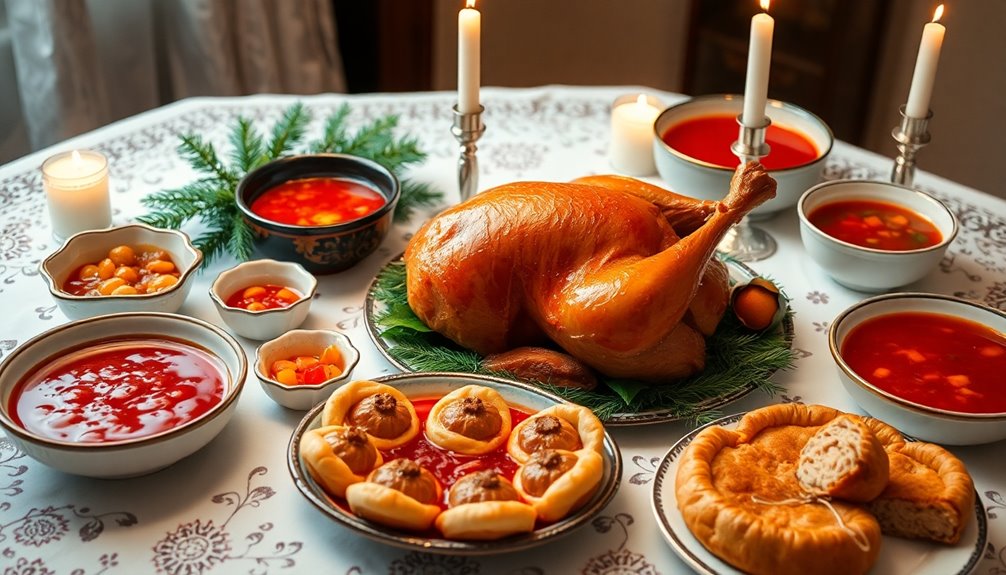
Traditional Christmas foods in the Russian Orthodox culture create a rich tapestry of flavors and symbolism, inviting families to gather in celebration.
On Christmas Eve, you'll enjoy a special meal called Sviata Vechera, featuring 12 meatless dishes that honor the apostles. One highlight is kutya, a sweet grain pudding made with wheat or rice, honey, and poppy seeds.
You might also savor vegetarian borscht, solyanka, pickled vegetables, and various fish dishes that emphasize unity and abundance. As the fast ends, families share Lenten bread dipped in honey and garlic.
To finish, you can sip vzvar, a sweet drink made from dried fruits and honey.
The Christmas Day meal often includes roasted pork or goose, showcasing regional customs.
Religious Observances and Practices
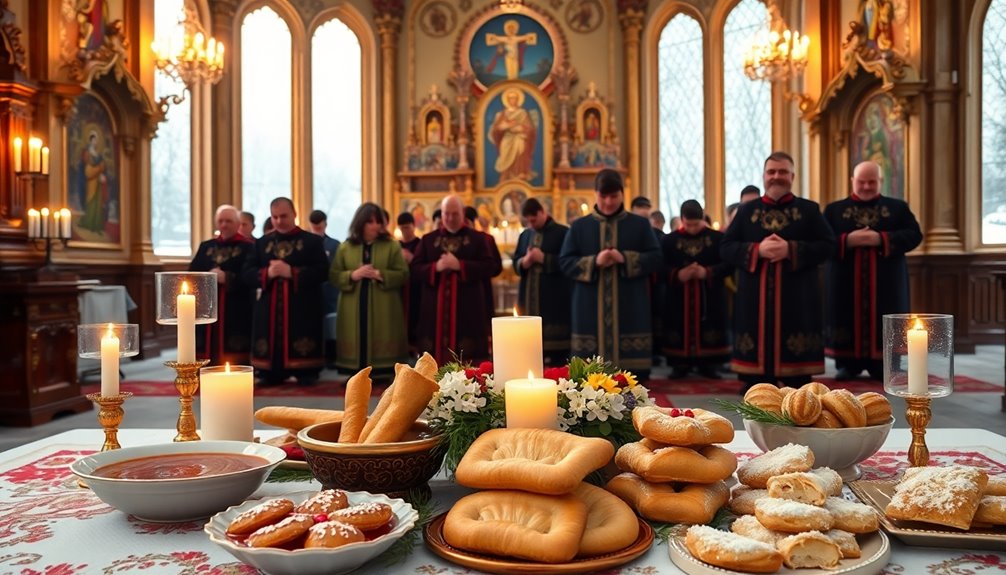
As you prepare for Russian Orthodox Christmas, attending the Midnight Mass is a must to honor the birth of Christ.
You'll also experience the significance of the Nativity Fast, which sets the spiritual tone leading up to this holy day.
Finally, joining in the Holy Supper provides a meaningful way to connect with traditions that celebrate faith and community.
Midnight Mass Attendance
On Russian Orthodox Christmas, you'll find many believers attending the midnight mass known as "Prazdnik," a pivotal moment that celebrates the birth of Jesus Christ.
This beautiful service starts on Christmas Eve and includes heartfelt prayers and hymns, immersing you in the spirit of the Nativity.
As you participate, you might experience:
- The warmth of community gathered for church services.
- The awe of beautifully adorned icons depicting the Nativity.
- The solemnity of the Divine Liturgy following the All Night Vigil.
- The joy of breaking the fast with twelve traditional dishes, symbolizing the apostles.
This sacred night is a profound expression of faith for every Orthodox Christian, creating lasting memories and spiritual depth.
Nativity Fast Observance
While many people enjoy festive feasts during the holiday season, Russian Orthodox Christians observe the Nativity Fast as a meaningful period of reflection and spiritual renewal.
Lasting 40 days from November 28 to January 6, this fasting period involves abstaining from meat and dairy to focus on spiritual preparation.
Throughout the fast, you'll find prayers and hymns playing a significant role in daily life, with many attending church services and special liturgies emphasizing repentance.
On Christmas Eve, families typically refrain from eating until the first star appears, marking the end of the fast.
This culminates in a joyous Holy Supper featuring twelve dishes, symbolizing the apostles, celebrating the spirit of the season before the midnight church service.
Holy Supper Traditions
Celebrated on Christmas Eve, Holy Supper is a deeply cherished tradition for Russian Orthodox Christians, consisting of twelve meatless dishes that honor the apostles. This special meal begins when the first star appears in the sky, symbolizing the Star of Bethlehem.
Families gather around a beautifully set table, covered with a white tablecloth that represents Jesus's swaddling clothes.
Here are some key elements of Holy Supper that evoke emotion:
- Kutya – the sweet grain pudding served first, rich in cultural significance.
- Hay – placed under the tablecloth, reminding everyone of the manger.
- Prayers and hymns – creating a sacred atmosphere.
- Midnight church service – celebrating the Nativity together as a community.
Folklore and Cultural Celebrations
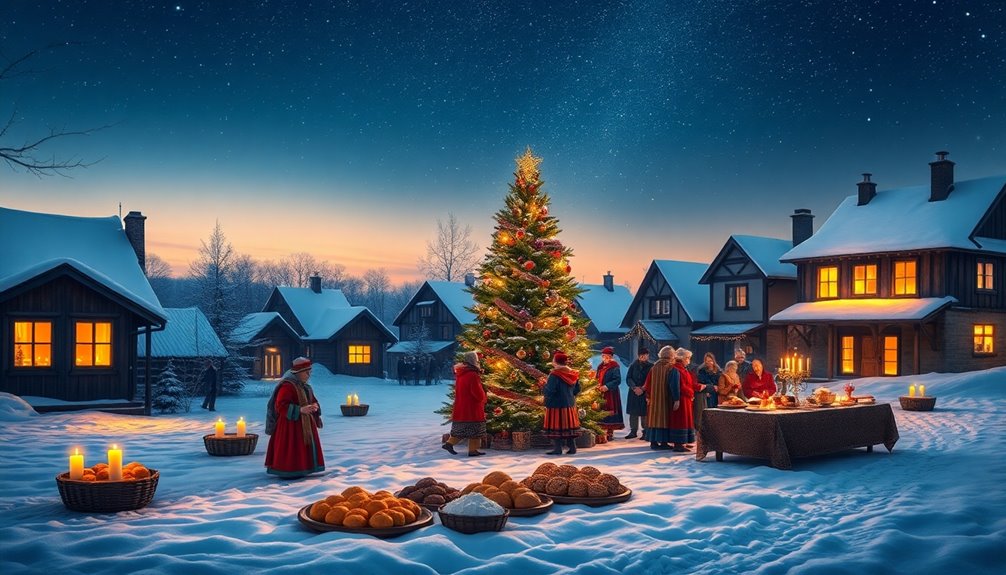
As you explore the rich tapestry of Russian Orthodox Christmas traditions, you'll discover a vibrant blend of folklore and cultural celebrations that span centuries.
Koliada, a pre-Christian winter festival, invites you to join in caroling and Mummers plays, where participants embody folklore characters and share festive cheer.
On Christmas morning, children go door-to-door singing "kolyadki," receiving blessings and treats as part of the joy.
The period of Svyatki follows, filled with fortune-telling rituals and communal gatherings, merging pagan customs with Christian beliefs.
You may hear the touching tale of Babushka, an old woman searching for the baby Jesus, emphasizing longing during this season.
Traditional crafts, like nesting dolls and lacquer boxes, serve as cherished gifts, celebrating Russian craftsmanship.
Modern Adaptations and Variations
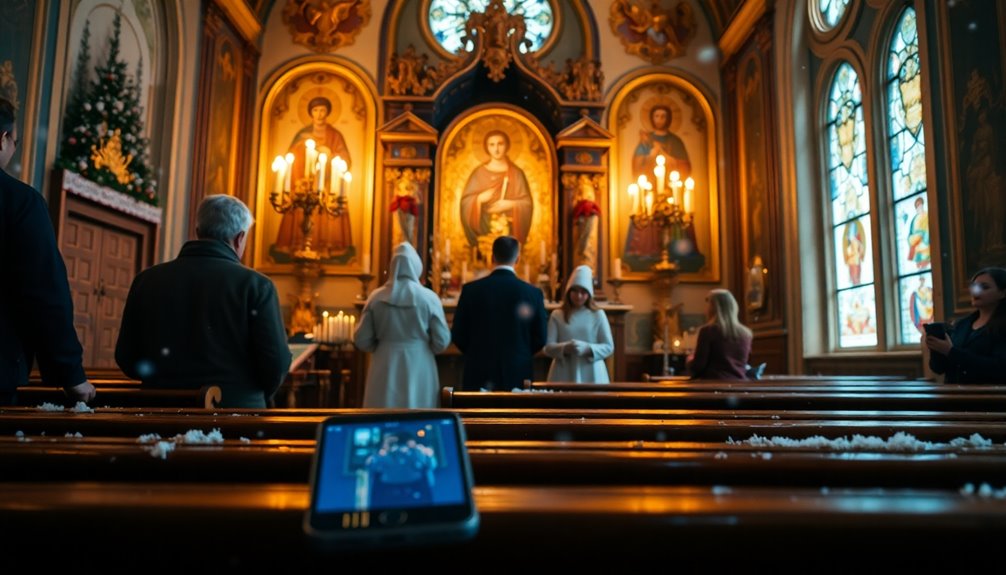
The vibrant blend of folklore and cultural celebrations has evolved as modern Russian Orthodox Christmas traditions take shape.
As you explore these contemporary practices, you'll notice:
- Christmas trees adorned with lights and ornaments, merging traditional and modern styles.
- A shift in gift exchanges to New Year's, making Christmas a quieter, more religious holiday focused on family.
- Urban areas buzzing with Christmas-themed events that mix old customs with modern entertainment.
- A revival of public Christmas markets showcasing traditional foods and crafts, celebrating cultural heritage.
These adaptations reflect how Russian communities embrace their Orthodox roots while welcoming new influences, creating a unique holiday experience that honors both the past and present.
Frequently Asked Questions
How to Celebrate Russian Orthodox Christmas?
To celebrate Russian Orthodox Christmas, start by attending a midnight church service, known as "Prazdnik."
Before that, enjoy a festive meal called "Sviata Vechera," featuring twelve meatless dishes, and don't forget the sweet "Kutya."
Set your table with a white cloth and hay to symbolize Jesus's manger. Light candles to represent Christ's light.
Join family and friends for caroling, and engage in fortune-telling rituals to embrace the holiday spirit and traditions.
What Are 4 Christmas Traditions in Russia?
You might think Christmas is all about feasting, but in Russia, it's a bit more reserved.
First, you'd enjoy a meatless meal called "Sviata Vechera" with twelve dishes.
Next, you'd attend midnight mass, embracing the spiritual side of the holiday.
Caroling, or "Kolyadki," has you singing for treats, while homemade decorations add warmth to your home.
It's a rich blend of tradition and faith that'll leave you feeling festive despite the cold!
How Do You Celebrate Orthodox Christmas Day?
To celebrate Orthodox Christmas Day, you typically start by attending the morning Divine Liturgy, joining your community in worship.
After church, you gather with family for "Sviata Vechera," enjoying twelve meatless dishes, including the sweet "Kutya."
You greet each other with "C Rodzhestvom Kristovom!" and may partake in caroling, visiting neighbors to share joy and treats.
It's a time for togetherness, reflection, and honoring traditions that strengthen your bonds with family and friends.
What Is the Difference Between Russian Christmas and American Christmas?
When you compare Russian and American Christmas, you'll notice key differences.
Russian Christmas falls on January 7, while American Christmas is December 25.
You'll enjoy a meatless Christmas Eve feast of 12 dishes in Russia, but in America, it's often a roasted meat dinner.
Gift-giving in Russia happens on New Year's Eve, unlike the American tradition of exchanging gifts on Christmas Day.
Plus, Russian customs intertwine with pre-Christian practices, unlike the commercialized American approach.
Conclusion
As you celebrate Russian Orthodox Christmas, remember that "home is where the heart is." Embrace the warmth of family gatherings, savor traditional foods, and engage in spiritual practices that connect you to centuries of history. The blend of folklore and modern adaptations enriches the experience, making it both meaningful and joyous. By honoring these traditions, you not only celebrate a holiday but also create lasting memories that can be cherished for years to come.
